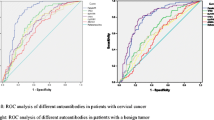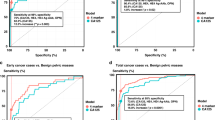Abstract
Background
Overexpression of tumor-associated antigens has been reported in many types of cancer and may trigger secretion of their autoantibodies. The present work was designed to test whether circulating antibody to FOXP3 protein-derived antigens was altered in early cervical cancer and cervical benign tumors.
Methods
A total of 141 patients with cervical cancer, 133 patients with cervical benign tumors and 148 healthy age-matched volunteers were recruited. The level of circulating anti-FOXP3 IgG antibody was tested using an enzyme-linked immunosorbent assay developed in-house with linear peptide antigens derived from FOXP3 protein. The linear peptide antigens were designed according to the computational prediction of HLA-II epitopes.
Results
Student’s t test showed that anti-FOXP3 IgG in the malignant tumor group and the benign tumor group was significantly higher than in the control group (t = 6.127, p < 0.001; t = 2.704, p = 0.007). In addition, patients with stage I cervical cancer (t = 2.968, p = 0.003) had a significantly higher level of FOXP3 autoantibodies than patients with benign tumors. The sensitivity against >90 % specificity was 20.6 % with an interassay deviation of 11.7 % in the cervical cancer group. Based on a cut-off value determined by the 98th percentile of the control group IgG levels, the anti-FOXP3 IgG positivity was 2.1 % in patients with cervical cancer compared to 2.0 % in the health controls (chi-squared = 0.004, p = 0.952, OR = 1.051, 95 % CI 0.209–5.295).
Conclusion
The circulating autoantibody to FOXP3 reflecting the continuous development of the cervical lesion, may be a potential biomarker with early prognostic values for cervical cancer.

Similar content being viewed by others
References
Parkin DM, Bray F, Ferlay J et al (2005) Global cancer statistics, 2002. CA Cancer J Clin 55(2):74–108
Yanan Wu (2009) The screening methods of cervical carcinoma at early stage. J Liaoning University Traditional Chin Med 11(6):65–67
Anderson KS, LaBaer J (2005) The sentinel within: exploiting the immune system for cancer biomarkers. J Proteome Res 4(4):1123–1133
Zaenker P, Ziman MR (2013) Serologic autoantibodies as diagnostic cancer biomarkers—a review. Cancer Epidemiol Biomarkers Prev 22(12):2161–2181
Coffer PJ, Burgering BM (2004) Forkhead-box transcription factors and their role in the immune system. Nat Rev Immunol 4(11):889–899
Fontenot JD, Rasmussen JP, Williams LM et al (2005) Regulatory T cell lineage specification by the forkhead transcription factor foxp3. Immunity 22(3):329–341
Hori S, Nomura T, Sakaguchi S (2003) Control of regulatory T cell development by the transcription factor Foxp3. Science 299(5609):1057–1061
Whiteside TL (2014) Regulatory T cell subsets in human cancer: are they regulating for or against tumor progression? Cancer Immunol Immunother 63(1):67–72
Wolf AM, Wolf D, Steurer M et al (2003) Increase of regulatory T cells in the peripheral blood of cancer patients. Clin Cancer Res 9(2):606–612
Woo EY, Chu CS, Goletz TJ et al (2001) Regulatory CD4(+)CD25(+) T cells in tumors from patients with early-stage non-small cell lung cancer and late-stage ovarian cancer. Cancer Res 61(12):4766–4772
Liu L, Liu N, Liu B et al (2012) Are circulating autoantibodies to ABCC3 transporter a potential biomarker for lung cancer? J Cancer Res Clin Oncol 138(10):1737–1742
Cheng Y, Xu J, Guo J et al (2013) Circulating autoantibody to ABCC3 may be a potential biomarker for esophageal squamous cell carcinoma. Clin Transl Oncol 15(5):398–402
Zhang C, Ye L, Guan S et al (2014) Autoantibodies against p16 protein-derived peptides may be a potential biomarker for non-small cell lung cancer. Tumour Biol 35(3):2047–2051
Jin Y, Guan S, Liu L et al (2014) Anti-p16 autoantibodies may be a useful biomarker for early diagnosis of esophageal cancer. Asia Pac J Clin Oncol. doi:10.1111/ajco.12198
Wang W, Guan S, Sun S et al (2014) Detection of circulating antibodies to linear peptide antigens derived from ANXA1 and DDX53 in lung cancer. Tumor Biol 35(5):4901–4905
Ye L, Guan S, Zhang C et al (2013) Circulating autoantibody to FOXP3 may be a potential biomarker for esophageal squamous cell carcinoma. Tumour Biol 34(3):1873–1877
Cunha LL, Morari EC, Nonogaki S et al (2012) Foxp3 expression is associated with aggressiveness in differentiated thyroid carcinomas. Clinics (Sao Paulo) 67(5):483–488
Tan EM, Zhang J (2008) Autoantibodies to tumor-associated antigens: reporters from the immune system. Immunol Rev 222:328–340
Wang LH, Su L, Wang JT (2010) Correlation between elevated FOXP3 expression and increased lymph node metastasis of gastric cancer. Chin Med J (Engl) 123(24):3545–3549
Niu J, Jiang C, Li C et al (2011) Foxp3 expression in melanoma cells as a possible mechanism of resistance to immune destruction. Cancer Immunol Immunother 60(8):1109–1118
Tan HT, Low J, Lim SG et al (2009) Serum autoantibodies as biomarkers for early cancer detection. FEBS J 276(23):6880–6904
Chen H, Werner S, Tao S et al (2014) Blood autoantibodies against tumor-associated antigens as biomarkers in early detection of colorectal cancer. Cancer Lett 346(2):178–187
Werner S, Chen H, Tao S et al (2014) Systematic review: serum autoantibodies in the early detection of gastric cancer. Int J Cancer. doi:10.1002/ijc.28807
Erfani N, Hamedi-Shahraki M, Rezaeifard S et al (2014) FoxP3+ regulatory T cells in peripheral blood of patients with epithelial ovarian cancer. Iran J Immunol 11(2):105–112
Hanakawa H, Orita Y, Sato Y et al (2014) Regulatory T-cell infiltration in tongue squamous cell carcinoma. Acta Otolaryngol 134(8):859–864
Azzimonti B, Zavattaro E, Provasi M et al (2015) Intense Foxp3+ CD25+ regulatory T cell infiltration is associated with high-grade cutaneous squamous cell carcinoma and counterbalanced by CD8+ /Foxp3+ CD25+ ratio. Br J Dermatol 172(1):64–73
Shibuya KC, Goel VK, Xiong W et al (2014) Pancreatic ductal adenocarcinoma contains an effector and regulatory immune cell infiltrate that is altered by multimodal neoadjuvant treatment. PLoS One 9(5):e96565
Kim S, Lee A, Lim W et al (2014) Zonal difference and prognostic significance of FOXP3 regulatory T cell infiltration in breast cancer. J Breast Cancer 17(1):8–17
Raghavan S, Quiding-Järbrink M (2011) Regulatory T cells in gastrointestinal tumors. Expert Rev Gastroenterol Hepatol 5(4):489–501
Merlo A, Casalini P, Carcangiu ML et al (2009) FOXP3 expression and overall survival in breast cancer. J Clin Oncol 27(11):1746–1752
Wolf AM, Rumpold H, Wolf D et al (2007) Role of forkhead box protein 3 expression in invasive breast cancer. J Clin Oncol 25(28):4499–4500
Hou F, Li Z, Ma D et al (2012) Distribution of Th17 cells and Foxp3-expressing T cells in tumor-infiltrating lymphocytes in patients with uterine cervical cancer. Clin Chim Acta 413(23–24):1848–1854
Jaafar F, Righi E, Lindstrom V et al (2009) Correlation of CXCL12 expression and FoxP3+ cell infiltration with human papillomavirus infection and clinicopathological progression of cervical cancer. Am J Pathol 175(4):1525–1535
Loddenkemper C, Hoffmann C, Stanke J et al (2009) Regulatory (FOXP3+) T cells as target for immune therapy of cervical intraepithelial neoplasia and cervical cancer. Cancer Sci 100(6):1112–1117
Scott ME, Ma Y, Kuzmich L et al (2009) Diminished IFN-gamma and IL-10 and elevated FOXP3 mRNA expression in the cervix are associated with CIN 2 or 3. Int J Cancer 124(6):1379–1383
Zeng C, Yao Y, Jie W et al (2013) Up-regulation of Foxp3 participates in progression of cervical cancer. Cancer Immunol Immunother 62(3):481–487
Caron M, Choquet-Kastylevsky G, Joubert-Caron R (2007) Cancer immunomics using autoantibody signatures for biomarker discovery. Mol Cell Proteomics 6(7):1115–1122
Chapman CJ, Healey GF, Murray A et al (2012) Early CDT®-Lung test: improved clinical utility through additional autoantibody assays. Tumour Biol 33(5):1319–1326
Acknowledgments
This study was supported by Jilin Pharmaceutical Industry Development Special Fund Project (No. 130701YY01066802). We would like to acknowledge Dr. Cui Manhua and colleagues for their help and support with serum sample processing.
Conflict of interest
All the authors declare that they have no conflict of interest.
Author information
Authors and Affiliations
Corresponding authors
About this article
Cite this article
Xu, S., Huangfu, M., Jia, X. et al. FOXP3 autoantibody as a potential early prognostic serum biomarker in patients with cervical cancer . Int J Clin Oncol 20, 982–988 (2015). https://doi.org/10.1007/s10147-015-0797-4
Received:
Accepted:
Published:
Issue Date:
DOI: https://doi.org/10.1007/s10147-015-0797-4




